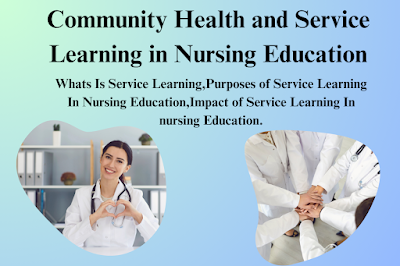Community Health and Service Learning in Nursing Introduction
In recent years, service learning has emerged as a transformative pedagogical approach within nursing education, bridging the gap between academic learning and community service. By integrating academic knowledge with practical community service, service learning enhances students’ educational experiences while addressing real-world health challenges. This comprehensive discussion delves into the concept of service learning, its purposes in nursing education, and its impact on both students and communities.
What is Service Learning?
Service learning is an educational method that combines formal academic learning with community service activities, creating a reciprocal relationship between students, educators, and community partners. Unlike traditional volunteer work, service learning is purposefully designed to achieve both educational and community goals simultaneously. The core of service learning lies in the mutual benefit it provides: students gain practical experience and insights, while the community receives valuable support and services.
Service learning is characterized by its flexibility and adaptability, making it a suitable approach for various disciplines, particularly in nursing education. According to Cruz and Giles (2000) and Moore (2013), the nature of service learning is dynamic, resisting simplistic theoretical definitions due to its diverse applications and outcomes. In the context of nursing, service learning often involves activities such as health education, community outreach, and direct patient care in diverse settings.
Purposes of Service Learning in Nursing Education
Service learning in nursing education has its roots in the early 20th century, reflecting the historical practice of nursing in diverse community settings. Over time, the principles of service learning have evolved to meet the changing needs of both students and communities. The main purposes of service learning in nursing education include:
- Integration of Health Concepts: Service learning integrates key nursing concepts, such as social determinants of health, social justice, and cross-cultural nursing, into practical experiences. By addressing real-world health issues, students gain a deeper understanding of these concepts and their relevance to patient care (Gillis & MacLellan, 2010; Groh, Stallwood, & Daniels, 2011).
- Development of Critical Skills: Service learning fosters critical self-awareness, empathy, and problem-solving skills among nursing students. Engaging in community service helps students develop these skills by working in resource-challenged environments and addressing complex health conditions (Amerson, 2012; Green, Comer, Elliott, & Neubrander, 2011).
- Addressing Clinical Placement Shortages: With the increasing shortage of traditional clinical placements, service learning provides an alternative way for students to gain practical experience. By practicing in real-world settings, students can achieve the principles of primary health care where people live, work, and worship (Pijl Zieber & Kalischuk, 2011).
- Needs Assessment and Advocacy: Service learning often begins with a needs assessment of specific populations, such as school children, older adults, or international communities. Through this process, students identify community needs, make referrals, and advocate for change, thereby contributing to the improvement of health outcomes (Eymard et al., 2013; Ross, 2012; Tsai, 2013; Amerson, 2012).
- Focus on Learning Outcomes: While service learning projects often aim to achieve specific service outcomes, they primarily emphasize learning outcomes. The complexity of measuring service outcomes necessitates a focus on educational benefits, such as the development of practical skills and increased understanding of health issues (Cruz & Giles, 2000).
Impact of Service Learning in Nursing Education
Service learning has a profound impact on nursing education, benefiting both students and the communities they serve. The main impacts include:
- Enhanced Educational Experience: Service learning enriches the educational experience by providing students with hands-on opportunities to apply theoretical knowledge in real-world settings. This practical application helps students develop critical thinking, clinical reasoning, and problem-solving skills, essential for effective nursing practice (Amerson, 2012; Green et al., 2011).
- Improved Community Health: Through service learning, nursing students contribute to the health and well-being of diverse communities. By addressing pressing health needs and providing education and support, students help improve community health outcomes. For example, projects targeting school children or older adults can lead to better health practices and increased access to necessary services (Bassi, 2011; Du Plessis, Koen, & Bester, 2013).
- Strengthened Community Partnerships: Service learning fosters strong partnerships between nursing schools and community organizations. These collaborations enhance the effectiveness of health interventions and create opportunities for continued community engagement. By working closely with community partners, nursing programs can tailor their services to meet local needs and build trust within the community (Belcher et al., 2012).
- Development of Professional Skills: Service learning helps students acquire essential professional skills, including communication, advocacy, teaching, and referral. These skills are crucial for effective nursing practice and are developed through direct interactions with patients and community members. Additionally, the experience of working in resource-challenged environments prepares students for the complexities of real-world nursing (Gillis & MacLellan, 2010; Groh, Stallwood, & Daniels, 2011).
- Increased Empathy and Cultural Competence: Engaging in service learning enhances students’ empathy and cultural competence. By working with diverse populations and addressing a range of health issues, students gain a deeper understanding of the social determinants of health and the challenges faced by different communities. This increased awareness contributes to more compassionate and culturally sensitive care (Amerson, 2012; Green et al., 2011).
Conclusion
Service learning represents a powerful pedagogical approach that enhances nursing education by integrating academic learning with community service. Through service learning, nursing students gain practical experience, develop critical skills, and contribute to the health and well-being of diverse communities. The impact of service learning extends beyond the classroom, fostering stronger community partnerships, improving health outcomes, and preparing students for the complexities of real-world nursing practice.
As nursing education continues to evolve, the integration of service learning will remain a valuable tool for addressing clinical placement shortages, promoting social justice, and enhancing students’ educational experiences. By embracing service learning, nursing programs can cultivate a new generation of compassionate, skilled, and culturally competent healthcare professionals dedicated to improving community health.

1 thought on “Community Health and Service Learning in Nursing Education”